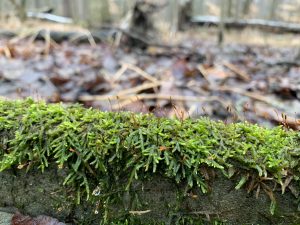At this point it’s hard to see humans totally disentangling themselves from nature. Like McKibben says, the frontiers are all gone, there isn’t anywhere the boot of man has yet to tread. With that in mind, places like Johnson Woods are impressive in their overall respect for the surrounding natural world. Located on a small backroad and surrounded by acres of farmland, the forest is a large stand of trees a passerby might overlook. The woods themselves are relatively undisturbed, the only human structure being the boardwalk that snakes through the woods and over the marshy areas.
Although with the boardwalk it’s impossible to forget human civilization, I’d argue that humans would always be present in one’s conscious anyway, with or without the boardwalk. This constant reminder manifests not only in the crude carvings on nearly every single beech along the path, but also in the historically unfamiliar organisms residing there. When we first stepped off the bus we were instantly reminded of the meddlings of humans in nature by the thousands of starlings in the neighboring field, a species introduced solely for their brief appearance in Henry IV.
Additionally, the boardwalk may be less sinister than one would think. I initially criticized it for hugging the forest floor, lamenting the habitat fragmentation it was likely leading to. Even though the width of the walk isn’t substantial, structures like these can impose significant barriers to various ground-dwelling fauna, like small insects and mammals. However, upon closer investigation, the boardwalk was set a few centimeters above the soil, allowing for mobility through the seemingly bifurcated environment. When paying closer attention to the path, I noticed that it too was teaming with life, supporting many fungal and moss communities. These intrepid settlers had surpassed merely surviving, they thrived in this environment, as could be seen by their protruding sporophytes, or their spore producing structures. These tiny sporophytes asserted themselves in this human-nature hybrid habitat, promising a new generation to come.

